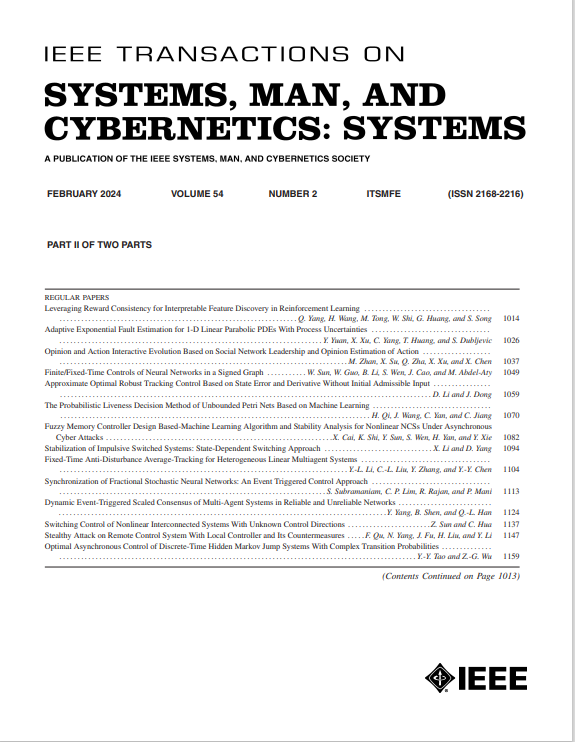When Process Control Meets Big Data: Data-Driven Cloud-Edge Collaborative Predictive Control Method for Multiple Operating Conditions Processes
IF 8.7
1区 计算机科学
Q1 AUTOMATION & CONTROL SYSTEMS
IEEE Transactions on Systems Man Cybernetics-Systems
Pub Date : 2025-07-08
DOI:10.1109/TSMC.2025.3582880
引用次数: 0
Abstract
Complex industrial processes often run under varying operating conditions. Learning-based control methods are difficult to adapt to these unknown variations. Therefore, it is necessary to update the model and control strategy adaptively. However, in traditional control frameworks, due to the limitation of computational and storage resources of edge devices, control strategies are difficult to update once deployed, which leads to model mismatch after operating condition change and seriously reduces the control performance. To solve this problem, this article proposes a novel cloud-edge collaborative control method. Specifically, a cloud-assisted parallel subspace identification method is proposed, which fully utilizes the powerful computational capability of the distributed cluster in the cloud to achieve fast and accurate model identification. Then, an explicit control strategy is proposed, which solves the control law as a piece-wise affine function offline. The process model and explicit control law are sent down to the edge, enabling fast and precise control under limited resource constraints. An operating condition change detection method based on the process model is proposed, and the edge detects the emergence of new operating conditions by the prediction error. Meanwhile, to fully excite new operating condition characteristics, a joint control and excitation signal generator (JCESG) is designed. JCESG ensures accurate identification of new operating condition model under limited data, which in turn greatly shortens the operation condition switching process and ensures fast modeling and precise control in new operating conditions. Notably, considering that the proposed method can adaptively realize model identification and control law update, it is capable of adapting to the continuous change of operating conditions, and the sufficient excitation of JCESG greatly reduces the data volume requirement for model update, which further ensures that the method adapts to the full range of operating conditions. Finally, extensive experiments verified the superiority of the proposed method.当过程控制遇到大数据:多工况过程的数据驱动云边缘协同预测控制方法
复杂的工业过程经常在不同的操作条件下运行。基于学习的控制方法很难适应这些未知的变化。因此,有必要对模型和控制策略进行自适应更新。然而,在传统的控制框架中,由于边缘设备的计算和存储资源的限制,控制策略一旦部署就难以更新,导致运行条件变化后模型不匹配,严重降低了控制性能。为了解决这一问题,本文提出了一种新的云边缘协同控制方法。具体而言,提出了一种云辅助并行子空间识别方法,充分利用云中分布式集群强大的计算能力,实现快速准确的模型识别。然后,提出了一种显式控制策略,将控制律解为离线的分段仿射函数。将流程模型和显式控制律发送到边缘,在有限的资源约束下实现快速、精确的控制。提出了一种基于过程模型的工况变化检测方法,边缘通过预测误差检测新工况的出现。同时,为了充分激发新的工况特性,设计了联合控制和激励信号发生器(JCESG)。JCESG保证了在有限数据条件下对新工况模型的准确识别,从而大大缩短了工况切换过程,保证了新工况下的快速建模和精确控制。值得注意的是,该方法能够自适应地实现模型辨识和控制律更新,能够适应连续变化的运行工况,且JCESG的充分激励大大降低了模型更新所需的数据量,进一步保证了该方法对全工况的适应性。最后,通过大量的实验验证了所提方法的优越性。
本文章由计算机程序翻译,如有差异,请以英文原文为准。
求助全文
约1分钟内获得全文
求助全文
来源期刊

IEEE Transactions on Systems Man Cybernetics-Systems
AUTOMATION & CONTROL SYSTEMS-COMPUTER SCIENCE, CYBERNETICS
CiteScore
18.50
自引率
11.50%
发文量
812
审稿时长
6 months
期刊介绍:
The IEEE Transactions on Systems, Man, and Cybernetics: Systems encompasses the fields of systems engineering, covering issue formulation, analysis, and modeling throughout the systems engineering lifecycle phases. It addresses decision-making, issue interpretation, systems management, processes, and various methods such as optimization, modeling, and simulation in the development and deployment of large systems.
 求助内容:
求助内容: 应助结果提醒方式:
应助结果提醒方式:


